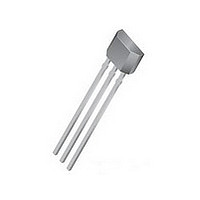A1184LUA Allegro Microsystems Inc, A1184LUA Datasheet - Page 11

A1184LUA
Manufacturer Part Number
A1184LUA
Description
IC SWITCH HALL EFFECT UNI 3-SIP
Manufacturer
Allegro Microsystems Inc
Type
Unipolar Switchr
Datasheet
1.A1184EUA.pdf
(15 pages)
Specifications of A1184LUA
Sensing Range
300G ~ 600G - Programmable, Fixed Release
Voltage - Supply
3.5 V ~ 24 V
Current - Supply
6.9mA
Output Type
Digital, Differential
Features
Programmable
Operating Temperature
-40°C ~ 150°C
Package / Case
3-SIP
Magnetic Type
Unipolar
Operating Supply Voltage (min)
3.5V
Operating Supply Voltage (typ)
5/9/12/15/18V
Operating Supply Voltage (max)
24V
Mag Sensor Operate Point (g)
600Gs
Mag Sensor Hysteresis(g)
15Gs
Package Type
Ultra Mini SIP
Pin Count
3
Mounting
Through Hole
Operating Temp Range
-40C to 150C
Operating Temperature Classification
Automotive
Lead Free Status / RoHS Status
Contains lead / RoHS non-compliant
Current - Output (max)
-
Lead Free Status / RoHS Status
Not Compliant, Contains lead / RoHS non-compliant
A1184
Programming Protocol
The operate switchpoint, B
so, a coded series of voltage pulses through the VCC pin is used
to set bitfields in onboard registers. The effect on the device
output can be monitored, and the registers can be cleared and
set repeatedly until the required B
setting permanent, bitfield-level solid state fuses are blown, and
finally, a device-level fuse is blown, blocking any further cod-
ing. It is not necessary to program the release switchpoint, B
because the difference between B
hysteresis, B
The range of values between B
31 increments. The actual change in magnetic flux (G) repre-
sented by each increment is indicated by B
Characteristics table; however, testing is the only method for
verifying the resulting B
ments are individually identified using 5 data bits, which are
physically represented by 5 bitfields in the onboard registers.
By setting these bitfields, the corresponding calibration value is
programmed into the device.
Three voltage levels are used in programming the device: a low
voltage, V
mid-level voltage, V
in the device; and a high voltage, V
V
long in duration). A fourth voltage level, essentially 0 V, is used
to clear the registers between pulse sequences. The pulse values
are shown in the Programming Protocol Characteristics table and
in figure 4.
PROGRAMMING PROTOCOL CHARACTERISTICS, over operating temperature range, unless otherwise noted
Programming Voltage
Programming Current
Pulse Width
Pulse Rise Time
Pulse Fall Time
1
2
provide the current necessary to blow the fuse.
Programming voltages are measured at the VCC pin.
A bypass capacitor with a minimum capacitance of 0.1 μF must be connected from VCC to the GND pin of the A118x device in order to
PM
pulses (when short in duration) and to blow fuses (when
Characteristic
PL
HYS
, a minimum required to sustain register settings; a
, is fixed.
PM
1
2
, used to increment the address counter
OP
). For programming, the 31 incre-
OP
, can be field-programmed. To do
OP(min)
Symbol
OP
OP
V
PH
V
t
t
t
V
I
d(P)
d(0)
d(1)
and B
PP
PM
t
t
is achieved. To make the
PH
PL
r
f
and B
, used to separate sets of
Chopper-Stabilized Unipolar Hall Effect Switch
RP
RES
Minimum voltage range during programming
t
OFF time between programming bits
Pulse duration for enable and addressing
sequences
Pulse duration for fuse blowing
V
V
r
OP(max)
PL
PM
= 11 μs; 5 V → 26 V; C
, referred to as the
(see the Operating
to V
to V
PM
is scaled to
Standard Two-Wire Field-Programmable
PL
; V
; V
PL
PH
to V
Test Conditions
to V
RP
PH
,
PL
BYP
Additional information on device programming and program-
ming products is available on www. allegromicro.com. Program-
ming hardware is available for purchase, and programming
software is available free of charge.
Code Programming.
do so, a pulse sequence must be transmitted for each bitfield that
is being set to 1. If more than one bitfield is being set to 1, all
pulse sequences must be sent, one after the other, without allow-
ing V
The same pulse sequence is used to provisionally set bitfields as
is used to permanently set bitfield-level fuses. The only differ-
ence is that when provisionally setting bitfields, no fuse-blowing
pulse is sent at the end of the pulse sequence.
= 0.1 μF
CC
to fall to zero (which clears the registers).
V
V
V
PH
PM
PL
0
V+
Figure 4. Pulse amplitudes and durations
T
d(1)
Each bitfield must be individually set. To
115 Northeast Cutoff
1.508.853.5000; www.allegromicro.com
Allegro MicroSystems, Inc.
Worcester, Massachusetts 01615-0036 U.S.A.
Min.
11.5
25.0
100
4.5
20
20
5
5
-
T
d(P)
T
d(0)
Typ.
12.5
26.0
190
300
5.0
-
-
-
-
Max.
13.5
27.0
100
5.5
t
20
-
-
-
-
Units
mA
μs
μs
μs
μs
μs
V
V
V
10










